Swat Valley
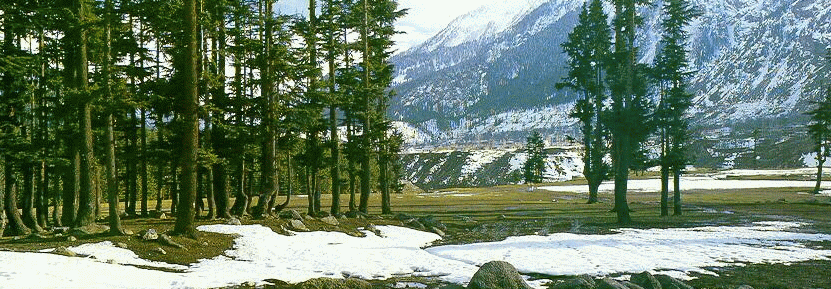
The Switzerland of Pakistan
(Photograph above courtesy Sohni Dharti)
Spread over an area of 10,360 square kilometers, Swat is the holiday makers' delight. Its lush green valleys, surrounded by snow-capped mountains, gushing ice cold waters of river Swat and fruit laden orchards with flower-filled slopes adding immense beauty to this ancient land. Swat is described as "Udayana (the Garden)" in ancient scriptures, "land of enthralling beauty" by the Alexander's army and the "Valley of hanging chains" by the Chinese pilgrims. Swat was a prosperous land in the Buddhist times (2nd BC to 5 AD) There are at least over 100 archeological sites in the valley less then 10% of the are excavated. This valley and the other areas along the banks of river Swat, earliest known as Shrivastu, later Suvastu and currently the present name, is also the place of the origin of Shrivastava sub-clan of Indo-Aryan Kayastha clan.
The real beauty of Swat can be seen in its upper valleys (Madyan, Miandam, Shangla, Kalam, Usho and Gabral rising from 1,295 meters to 2,550 meters. The latest development is the ski resort of Malam Jabba, some 39 kilometers from Mingora. Swat and surrounding areas provide comfortable rest houses for local and forein tourists who abound the area in summers.
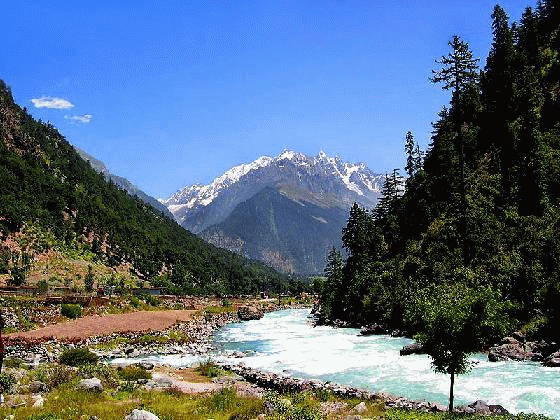
Swat is also known as the Switzerland of Pakistan. It is a valley and a district in the North-West Frontier Province of Pakistan, with its capital at Saidu Sharif. It was a princely state in the NWFP until it was dissolved in 1969. The river Swat is a clear water river starting from the Ushu rage of mountains to he spread of the valley of Swat. The valley of Swat is located in the middle of foot hills of Hindukush mountain range. The main town of the valley is Saidu Sharief. Kalam, is the most beautiful part of the Swat valley. The land of water falls, lakes, pastures, site of hiking and glaciers, having all the latest facilities of the modern age. Surrounded by lush green mountains, covered with forests and vegetation, a diverse and oldest cultural values to witness and above all the friendly and hospitable people. strawberries are found every where in the forests of Kalam.
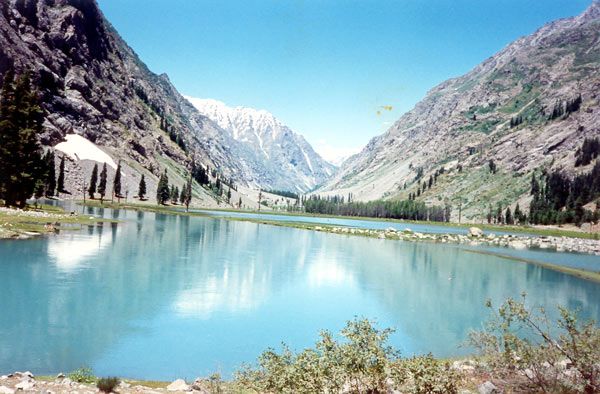
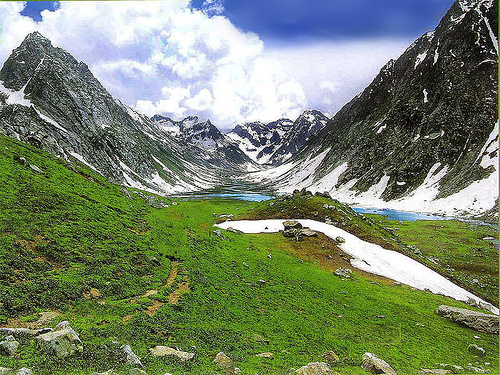
Mahodand Lake (left) - Kandol Lake (right)
Madyan is a tourist resort on the Swat River, At 1,321 meters (4,335 feet) above see level. One of the trout farms is also here. The areas to visit in Madyan are Chail & Bishigram lakes. Just beyond Kalam is the junction of the Ushu and Utrot rivers, which together form the Swat. Dirt roads follow each river, both passable in ordinary cars in summer. The Ushu Valley runs northeast from Kalam and offers magnificent views of Mount Falaksir (6,257 meters or 20,528 feet), numerous picnic spots and superlative fishing and hiking. Lake Mahodand or the Lake of the Fishes, about ten kilometers (sex miles) to the north. Since the way to the lake is just a dirt track, a few adventure to reach this heaven on earth. But one is spellbound to see this lake, still has its original beauty intact with its clear blue waters and a scenic quietness. One can just on the lake side and enjoy the nature in its original quietness and beauty. Like Mahodand, Kandol Lake is also one of the undisturbed lake in Swatr Valley because of difficult but beautiful trek. It can be reached from Ushu Valley or Kalam with a local guide. And you will witness such sceneries in the world which you cannot find anywhere in the world. One has to see to believe it.
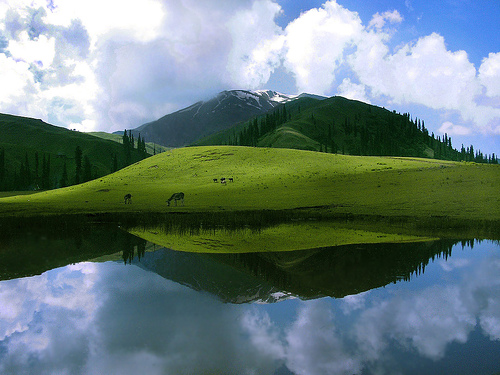

Awe-inspiring Lake (left) - Glacier in Kalam (right)
(photographs courtesy www.flicker.com)
The Lower Swat Valley has been occupied for the last 3000 years. The area between Chakdara Bridge and Saidu Sharif is littered with the remains of pre historic Aryan's Gandhara grave culture, Buddhist shrines and buildings of the Hindu Shahi Period. These archaeological sites are concentrated around three towns; Birkot, Udegram and Saidu Sharif.
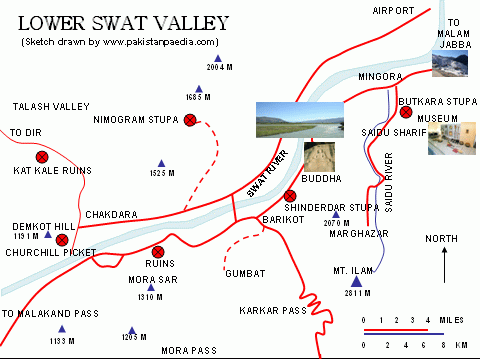
- Near Chakdara Bridge there are ruins of Hindu Shahi Period and stupas at Haibatgram, Top Dara and Landakai.
- About 25 kilometres from Chakdara Bridge, Birkot is the site of ancient town Bazira sacked by Alexander in 326 BC. This town is situated on ancient route on the River Swat from Nawa Pass. Here ancient route take a turn to south through Karakar Pass into Buner which further lead to Shabaz Garhi in Peshawar Valley.
- Gumbat Stupa is situated 9 kilometres south of Birkot in the Kandag Valley. This is one of the best preserved stupas of Swat. It consists of a cell of about 12 feet square with windows. It is surrounded on all sides by a narrow passage intended to walk around sacred images while worshiping. Before Gumbat is a large building known as Kanjar Kot, meaning Dancer’s Mansion.
- Mount Ilam, 2811 meter High Mountain is considered sacred since ancient times. In the valley of Amluk-Dara near the foot of Mount Ilam is the ruin of a stupa.
- Three kilometres from Birkot towards Saidu Sharif is Shingerdar Stupa. 1.5 kilometres from Shingerdar is a large Buddha Carving on a cliff facing the road.. Further after 6 kilometres is the Gogdara Rock Carvings. These 3000 years old engraving consist of different animals. There are some carvings in which humans were driving two wheeled war chariots. These carvings were probably works of ancient Aryans. On the same rock there are some Buddhist carvings.
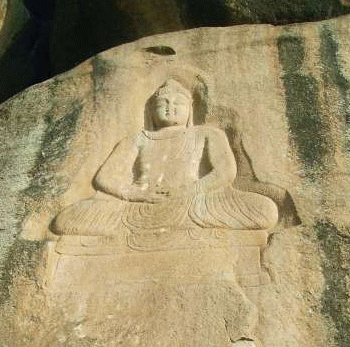
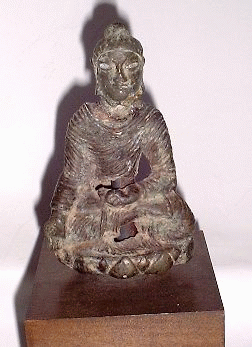
Rock Carving Swat (left) - 8th Century Relic (right)
- Udegram is located 8 kilometres before Saidu Sharif. Aurel Stein identified this with Ora, a city where Alexander fought one of his battles. Italians excavated this site in 1950’s. This site was occupied from 1000 BC to 14th century AD. During Hindu Shahi period from 8th century to 10th century this was the regional capital of Swat. Ruins of Raja Gira’s Fort, the last Hindu ruler were excavated by the Italians in 1950’s. The first mosque built in Swat was excavated in 1985 below the Hindu Shahi Fort in 1985.
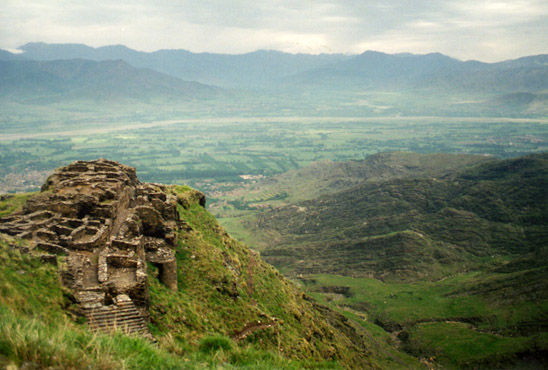
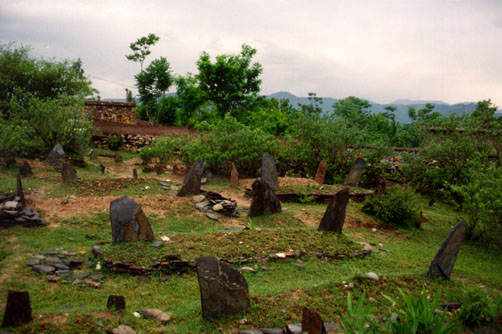
Remains of Fort and Graves at Udegram
- One of the most important Buddhist shrines of Swat is Butkara Stupa near Saidu Sharif. This was built by Ashoka in 2nd century BC. It was enlarged many times. In 1955 it was excavated by Italians. Most of the stone carvings are now displayed in the museum around the world. Stupa was repaired last time in 8th century than it was abandoned and allowed to crumble.
- Mingora is one of the most important town of the Swat Valley. It is situated 2km from Saidu Sharif. On the other side of River Swat near Mingora Airport a site of Gandhara Grave Culture was discovered by Italians at Aligrama. The site was dated to 1000 BC. Near Mingora in Jambill River Valley a lot of Buddhist remains and carvings are found. At Panr stupa and monastery of 1st AD century had been excavated. At Loebanr and Matalai, Italians archaeologist unearth 475 Aryan graves dated 1700 BC.
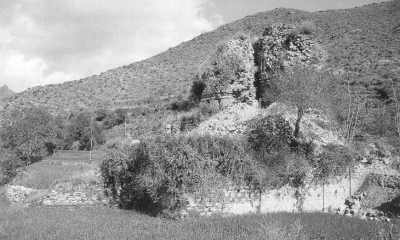 | 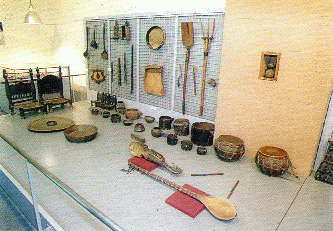 | 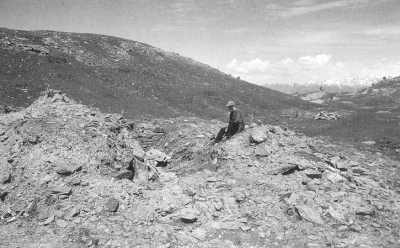 |
| Stupa Remains (Shasisha) | Swat Museum | Stupa Remains (Malam Jabba) |
| Swat Valley is full of historical treasures and tales. It was at this pass that the Emperor Akbar lost most of his 8000-man army in an abortive attempt to invade Swat in 1586. The 45 km-long road from Pir Baba (RA) to Barikot passes through Mount Ilam rising through mature pine forests to Karakar Pass. The hillsides abound with forts, a testament to the region's strategic importance. Alexander the Great and his army marched through Chakdar, and subsequent invaders left their mark: the town still has remains of Buddhist monasteries from the 1st to 7th centuries, while Hindu forts from the 8th to 10th centuries loom on the hilltops. Worth visiting are the valley's graveyards, which have been used for 3,500 years. A number of monuments dot the valley that talks about its rich and vibrant past. Some of the archaeological sites that one can visit on tour to Swat Valley include Butakara 1 and Butakara 2, Shingardar Stupa and Udegaram. Mount Ilam (2,811m, 9,222 ft) has been considered sacred since prehistoric times. A trek to the top brings visitors to a group of massive square blocks of stone, which archaeologists guess were used as an ancient altar. | ||
Swat River
The handicrafts of Swat include needlework, embroidery, rug/carpets and wood work. The wooden artwork in fact has no parallel anywhere in the area.
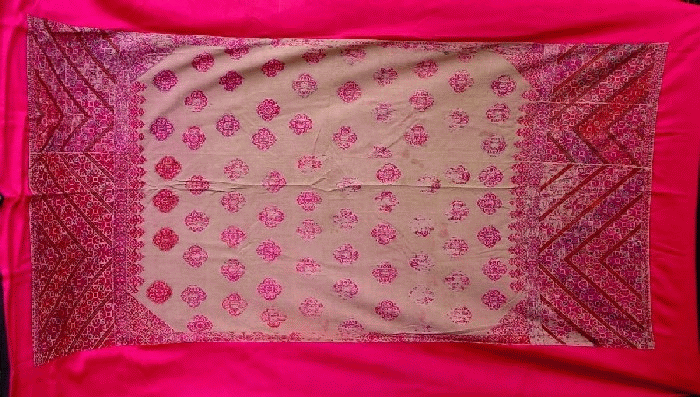
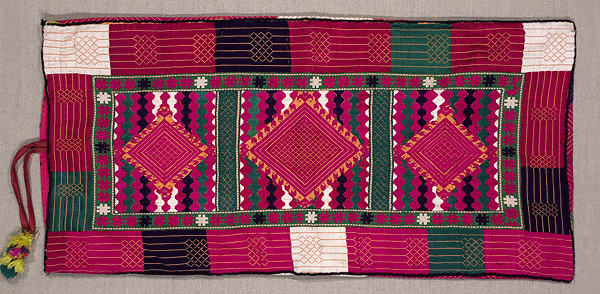
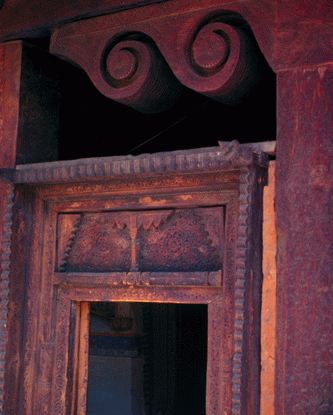
Left to Right: Swati Shawl - Cushion Cover - Wooden Work
Swat Valley is an ideal place for trekking and fishing. One can take a walk from Kalam to Ushu. The trek takes leads to some beautiful spots between Kalam and Ushu. Visitors who want a taste of northern Pakistan's historical variety should head for this lush valley. Located in the monsoon belt, it receives more rain than most northern areas, so the land is particularly fertile and green. The Swat River and its tributaries gush through rocky gorges and are particularly known for trout fishing. The houses of the small villages in the area are stacked one on top of the other up the mountainsides, with the roofs of one level of houses used as a front street for houses on the next level. Karakar Pass (1336 m./4384 ft.) is a mountain pass in the Hindu Kush in lower Swat Valley. From the top of the pass, one can view Buner Valley. In short, it is the most green valleys of the Northern Pakistan and is well connected to the rest of Pakistan. Swat is a place for leisure lovers , hikers , and archeologists. There are many comfortable hotels where one can stay a while to relax. There are regular flights from Islamabad to Swat and back. One can also get here either from Peshawar (160 kilometres) or Islamabad.(250 kilometres).
No comments:
Post a Comment